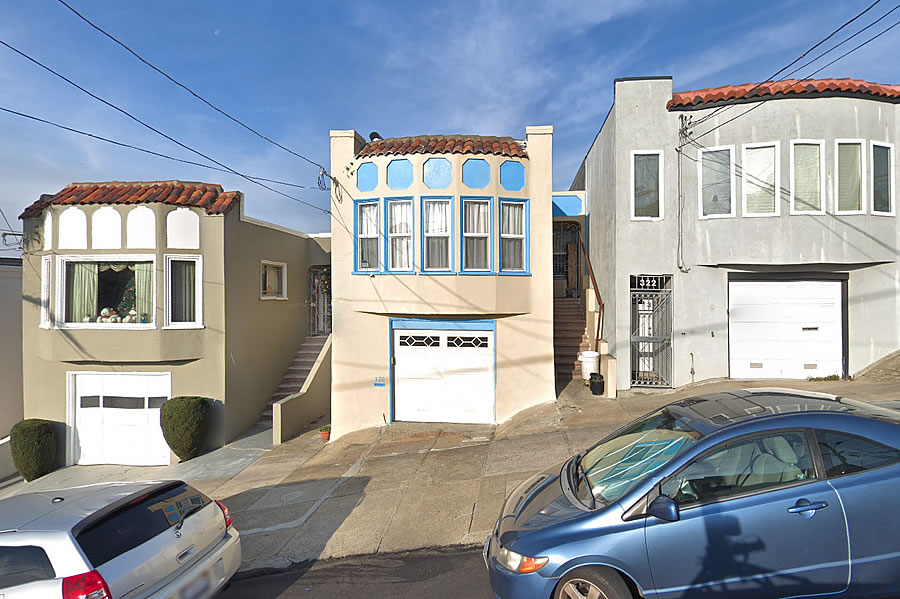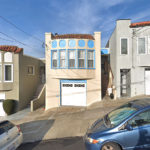With the inventory of homes for sale in San Francisco having recently hit a 7-year high, and pending sales down, the number of homes listed for sale in the city with a price tag of under a million dollars (330) is the most since the fourth quarter of 2016, both in terms of single-family homes and condos, and 50 percent more than at the same time last year.
Included in our count is the three-bedroom, two-bath Excelsior District home at 326 Prague Street pictured above, which has been on the market with a $998,000 price tag for the past 44 days.








Lotta $ for such a stucco wonder
It’s absurd what prices have gone to in SF for basically crappy housing. The worst housing stock of any West Coast city – but there is always the last greatest fool. That said, price increases per CS seem to be plateauing. Though they remain robust for SFHs. Condo prices have slipped a bit. The top tier is stagnant as the recent Marina and Tiburon posts at SS suggest. Same thing happening with top tier properties on the Peninsula.
Bottom line, the lower and mid-tier are still showing solid gains and holding the mean price up. But, as this post suggests, those tiers may be softening. CS will tell the tale. It won’t go negative, but I expect it to drop to 3% – 4% YOY gains for SF in the coming year. This has been in the cards since 2014/2014. SF and the Bay Area are in for a prolonged period of anemic home appreciation.
That should read “in the cards since 2014/2015.”
Did you take note that prices were actually increasing, as shown by the last several CS data posts? And did you comment along those lines at those times? Somehow I think you did not.
There are some who have been predicting the impending housing crash for several years. At least Dave has changed his prediction away from an impending crash to a continuation of the general price plateau.
Actually I have not changed my prediction. I never predicted a crash in prices – what I predicted, and still do, is a drop in Bay Area home appreciation to mirror the national average appreciation. Sluggish appreciation for an extended period, but no crash.
When SS linked to a 3 year old article recently it had some nice predictions about the impending recession in 2015.
I’ve turned negative, but that’s because of the risks from DC, not from anything in SF.
And new condo pricing (and sales), the specific segment to which we referred and called at the time, subsequently dropped an average of over 10 percent and remains down. But don’t let the facts or accuracy get in your way…
Is the claim that apples to apples price aggregate comparisons of condos are down 10% since 2015? Did I miss that data?
There’s nothing fundamentally wrong with these houses – they have good bones and nice design, solidly built. The problem is people have stopped maintaining them over the last 25-30 years. When I was a kid a lot of these homes still had lawns and a really nice appearance – when they are given some love, they really look nice.
Easy, easy, I live in one of these stucco wonders. Would a pristine Craftsman in Portland be better? Probably. But at least these rowhouse neighborhoods, aka ‘Baltimore-by-Bay,’ are reasonably walkable and scenic in their way. Best of all, I don’t have to drive everywhere. I dig.
A pristine Craftsman in Portland? Way, way better – and quite walkable and far more scenic – in a real way, not in “their way” – and, did I mention, far, far less expensive. I live in pneumonia gulch too BTW.
I thought you live in Oakland Dave. At least that is what you said in a past post. I must find it.
I too live in a Stucco house in the Parkside. At let it is a A-frame.
Shhhhhhhhhh…. don’t tell them.
Hey Mirolinda Man – Portland sucks. Please don’t come here. You’d hate it.
I love Portland. But if I moved there I’d have to spend the rest of my life in bended knee apologizing for being a native Californian. No thanks.
Also, I’d just get to watch the same people who ruined San Francisco ruin Portland. No thanks.
Don’t you think it’s weird to describe yourself as someone who ruined Portland?
Huh? I’m from here. Thanks.
Plus Portland is one of the least diverse cities on the west coast. No thanks.
Lived 5 years in PDX. 9 months of incessant rain will never beat any neighborhood in SF. Plus their homeless issue is worse than ours.
The featured house here feels classic, stats looks good, some alluring photos, then you see the clapboard downstairs unit. Why aren’t places like this listed as multifamily? Not permitted?
I want to believe that the market might come back down to earth, but with upcoming IPOs from companies like Uber, Lyft, Airbnb, Stripe, etc, etc …. there are going to be a lot of young people/couples with a lot of cash.
My bet is that the stucco wonders will keep getting snapped up at a price just short of “laughable” insanity (right now we’re just at “insanity” IMO… I’m crying, not laughing).
But then, after the latest tech cash wad is blown, I’d be very nervous about owning real estate here in the 7×7, in an environment where prices are declining everywhere else… and owning on a major faultline, in a metro region that has priced out everyone with non-coding skills.
How does stucco perform under heavy shaking?
a) You pretty grossly overestimate how much money the average employee makes from an IPO.
b) Stucco performs fine, given that the overwhelming majority survived Loma Prieta just fine.
He didn’t mention a specific dollar figure for IPO liquidity, nor did you. It’s reasonable to expect that the average engineer or otherwise mid level employee to become liquid on low to mid six figures in a decacorn ($10B valuation) IPO. Add that to someone other source of savings this is another source of capable local buyers.
“average engineer or otherwise mid level employee to become liquid on low to mid six figures”
Post-Tax and amortized over the long period of time many of these companies have spent being private this ends up just being a nice bonus for the very small fraction of workers at successful IPO’s. Nice, but nothing that changes the housing economics of the region. Especially if you consider that some of these people may already be adequately housed. Either from prior savings or family or low/no down loans or via secondary market sales or collateralization of their shares.
These last two cycles have seen us awash in liquidity chasing a rising market, maybe during economic conditions were the housing market was restrained by a lack of lending and liquidity these ‘IPO effects’ would become significant, but I don’t think that’s the situation now.
These IPOs will represent life-changing money for a significant number of people. Many of them are likely to change their lives in response.
My spitball estimate, which I think is conservative, is that 2% of the company’s valuation will make it to the local housing market within a year or two after the IPO. Add maybe 3x for leverage. For a $10B company that’s 600 median SF homes, maybe 2-3 weeks of volume. For the IPOs on deck in 2019, that’s more than a year’s worth of volume.
Of course the stock market could easily derail the planned IPOs.
“Of course the stock market could easily derail the planned IPOs.”
..or the curious fact that few of these billion-dollar valuation unicorns break even, let alone turn (or ever will turn) a profit…
Uber is now valued at $120B, so 12x that much. its a big deal and will net millions and millions to at least 200 employees
2 beers. they dont need to turn a profit to make people extremely rich. Uber was valued less than $5b 5 years ago and is now $120B, or 24x. anyone even at mid level who was there 5 years ago will be worth millions when it goes public (on day 1). doesnt matter if there is profit.
We don’t need no IPO…
Four months after some Uber employees were unable to sell as many shares in the company as they’d initially hoped, the ride-hailing company is offering a new deal that allows shareholders to turn some of their stock into money once again.
But then again, the rideshare mafia (aka SoftBank) has strings attached to their latest investment in Uber. Uber MUST go public in 2019 or suffer the consequences. This will not end well (or will it?)
it doesnt matter how much the average employee makes. if even the top 300 employees net (post tax) over $500K, it makes a big dent in a very tight market for supply
i was part of a small biotech that went public at $1.2B. because i was an early employee (not one of the earliest), and got a lot of stock at 100M valuations, i netted $4.5M after tax. these equity events change people lives and our supply is super tight.
Thanks for that. With that anecdote, you’ve illustrated two things that the average poster downplaying IPOs and acquisitions and mergers does not understand. One, there are scores of companies not on their radars whose employees wind up with significant windfalls. And two, the SF marketplace is never really awash in properties for sale. So an influx of capital into the margins in which the SF market exist will always move the needle.
Jimbo is exactly right (and congrats BTW). There is a lot of this happening and will continue to happen. Just taking a handful of the larger SF-based tech companies that *are* on people’s radar and using some math to estimate liquidity that, by most reasonable assumptions, will materialize via IPO or otherwise within the next 3-5 years:
*Airbnb, Instacart, Lyft, Uber, Stripe, Pinterest, Juul, Palantir (in Palo Alto)
*These companies currently employ ~40K workers
*Typical employee equity pool: 10% conservatively
*$250B in valuation at these companies, currently (incl. $120B for Uber recently)
=$625K average stock value per employee.
*This ignores many other companies that will get acquired or IPO that are smaller
Note: Avg. age at these companies is low. Many don’t own a house. Many will want to buy a house or upgrade when they become flush with cash.
Not much inventory (today) in SF. This will have a long term upward pressure on the local markets. Who knows what happens in the meantime though.
The employee pools aren’t evenly distributed. The larger IPOs will create a couple hundred new pre-tax, paper millionaires; the median will be well below $625K and the average ‘windfall’ will be less than the annual bonus for a decent banker or lawyer. Nearly all of the senior Uber, Airbnb and Lyft employees I know already own a condo/house or could afford one based on current salaries and bonuses, but some are planning to sell and upgrade.
“The employee pools aren’t evenly distributed. The larger IPOs will create a couple hundred new pre-tax, paper millionaires; the median will be well below $625K and the average ‘windfall’ will be less than the annual bonus for a decent banker or lawyer. ”
This is completely correct. And more so once you take out taxes and look at how many years of work went into this one-time lump sum payout.
But at a higher level, the real issue is that the ‘IPO effect’ is really a cause looking for an effect. Meaning that there isn’t really anything in the data that would require an ‘IPO effect’ to explain it. People postulated about these IPO’s in the 2007 cycle, but ultimately prices in the SF MSA rose and fell more or less in line with most other parts of the country. More importantly, price to income ration rose and then fell during that cycle. This cycle hasn’t been national, but if you look across cities many (mostly coastal) cities have had prices (and price-to-income) rise and level out mostly in line with each other. (In fact even Detroit has had a pretty good run up since the bottom)
In fact, while not an IPO, you can notice that the iPhone came out in 2007. And that no doubt led to a wave of hiring and bonusing and stock appreciation which most likely dwarfed what some of these IPO’s will yield. And yet that did nothing to decouple SF from the downslope of the broader market cycle.
Market momentum which affects nearly every buyer is going to be much stronger than something which affects only a select few (and even then only if they are in the Goldilocks zone of not already being adequately housed, getting enough that they don’t mind buying into a declining market, but not so much that they can cash out and go elsewhere so that their windfall will buy much more)
“i netted $4.5M after tax.”
But how many people in the bay area region just have salaries and didn’t get a windfall of anywhere near that size?
Back when the housing market was rising, all of those people were in play. If you level up into a rising market, things work out great. In fact, the rising market attracted investors and their capital from around the globe. But a high priced flat to down market is toxic to nearly all those people. Where you were once in a seething mass of buyers, you are now nearly alone in a very large room.
It’s not as if we hit rock bottom during a downturn with tumbleweeds running through the streets and vacant homes selling for $1. People make and lose fortunes asynchronous to what market cycles are doing. But outlying corner cases don’t move markets.
You keep talking about “how many people didn’t” and that is beside the point. The very point is the small margins. A small amount of buyers can move the needle for a quarter or two in a subsection (or three, or four) of a subsection of a market.
That’s a great point with respect to the margins, which is why even a small, or relatively large, change in inventory levels can have an outsized impact on the market in San Francisco, especially when actual buyer activity in the city is down.
And a large amount of buyers can move the needle a lot for a number of years. And the marginal difference to look at is the one between buyers in a rising vs flat vs falling market. That’s a large difference which accounts for the very large amplitude of this and the last RE cycles. And that tends to swamp out other effects which affect a very small number of buyers.
Now if you are talking founder, VC or C-level payouts and the ultra premium market they play in, that’s a different story. No amount of market appreciation will replicate a 9 figure payout.
Like any SS post you have the SF lovers and SF haters. Suffice it to say, if someone wants to spend a million bucks for this then go for it. I would rather spend my million elsewhere. It all comes down to what you want out of life. Some folks think the Bay Area is some kind of mecca. Others think it’s an overpriced cesspool of decaying infrastructure and homeless problems. As adults we can make our own decisions.
It’s more complicated than that. Noting that the infrastructure is decaying, the parks are poorly maintained, the streets are littered and the homeless problem is worsening does not make one a hater. Just an honest observer. There are many SF lovers who at the same hate what the city has/is becoming.
The parks are not poorly maintained.
At least we *have* infrastructure. Much of our benighted country is bereft of such things.
When you assert “…the homeless problem is worsening…”, over what time period is your observation? From the San Francisco bureau of the N. Y. Times piece we were talking about the other day:
Emphasis mine. Of course, the population of The City has increased just under 3% during the same period. I think this is a matter of increased visibility of the homeless, not a worsening homeless problem.
If you really want problems with homelessness, Portland is your place!
Seriously. Vacant lot encampments sanctioned by the city. Donuts, beers, and beards!
Opioids, desperation, and guilt compensation masquerading as progressive politics.
Seattle has not solved its homeless problem, either. Even with the amazing superior architecture Dave and only Dave can find. (As mediocre as the Excelsior may be, Seattle largely looks like Indianapolis with better scenery when it comes to residential architecture. And I would love to see how the Mission Bay Haters here would deal with the massive block long architectural wonders Seattle is building.)
I’m looking towards the future: the two huge issues SF and the Bay Area are facing, homelessness and traffic, is there any political willpower to improve them? I’d say the answer is no. Especially in SF proper, the inability of politicians to effectively tackle any real issues is laughable. So you can basically count on a declining quality of life.
Are you not following the current political climate regarding homelessness? Changes in approach will happen. The current mayor has basically staked her career on it. And there is a major initiative on the ballot that could potentially create a great deal of money to deal with the problem. Either way, changes are coming.
My contractor lives in the Excelsior district. Once I met him at a multi-unit home he was renovating in his neighborhood — it was a hodgepodge of mismatched styles that reduced the overall property value.
As for this house, I see the newbie contractor still thinks slippery stone on back splashes and walls are okay for kitchen floors. Should price it at $699,999 to “auction” it.
This is a outer-borough-close-cousin of the “designer showcase” house on Marina blvd.. Make a lot of bad or unusual aesthetic choices and you will get poor pricing.
YEAH BUT INVENTORY IS STILL BUILDING LIKE SS’S BEEN SAYING AND ITS EVERYWHERE MAN JUST LOOK AT DEEZ POSTS -backlink- -backlink- !!!!!
(Did I get enough of that right so you don’t have to say it?)
First it was only SOMA condos, then just all condos’s, then when bad SFH apples starting coming in people said that it was only high end homes, but the sub $1M market was on fire!
And again it just ends up looking like a classic cycle. Condos lead SFH’s. The lower end overshoots on the up (and undershoots on the down).
Of course there’s always a tighter correlation of price movement within a sub segment, but the people who think that a RE cycle will hit the rest of the market but pass over some particular sub-segment are usually dreaming.
Ok, I just looked this up. District 10 median days on market for September 2018 was just under 15. That’s tied to the historic low hit earlier this year. District 10 SFH prices have increased by slightly more than 10% in each, 2017 and 2018. Sure, you can go to any district and find an ugly, overpriced house sitting on the market for 44 days, but this is not at all representative of the real estate market in the southern neighborhoods of SF.
And yet, somehow inventory levels, the net change in which represents the difference between supply and demand, are actually on the rise in San Francisco.
And on a related note, did you see that 465 Marina Boulevard just sold for $7.2 million and “within 10 days of being listed” according to all industry stats and aggregate DOM reports! Of course, the seller had purchased the home for $8 million in 2015 and it was first listed five months ago…
Yes, inventory is on the rise, as it was in 2016. Did we see a price drop in 2017 and 2018? Also, can Socketsite please comment on the median days on the market figure for district 10?
Did we see the market weaken, sales drop and the sudden return of apples-to-apples losses (you know, “people who obviously just overpaid”) for 2015-era buys? Yes, we did. And in terms of our comment on the oft-quoted “median days on the market” metric in San Francisco: it’s about as valuable, and reliable as those “over asking!” stats.
Just a quick note regarding the Median Days on the Market stats. I agree that some of them are being manipulated, but I would assume that the share of the manipulated ‘median days on the market’ data points remains constant over time. Therefore, if I look at the movement of ‘median days on the market’ stats OVER TIME, I can get an idea if demand is strengthening or weakening.
That’s a poor assumption. The re-listing of properties which haven’t sold is actually more prevalent in weaker markets (in stronger markets the listings simply sell). Care to guess how that effects the ‘median days on the market’ OVER TIME?
Not only is it a “poor” assumption, isn’t it an entirely counter-intuitive one (?): the whole point of manipulating the data is things aren’t selling, so the more they aren’t selling, the more manipulating there will be. (An interesting theory to test would be so see if a graph (“”median vs. some measure of difficulty in selling) is parabolic: initially it goes up as sales lag but people are slow to manipulate, but then actually goes DOWN as more and more manipulation occurs and shorter faked listing periods are averaged in).